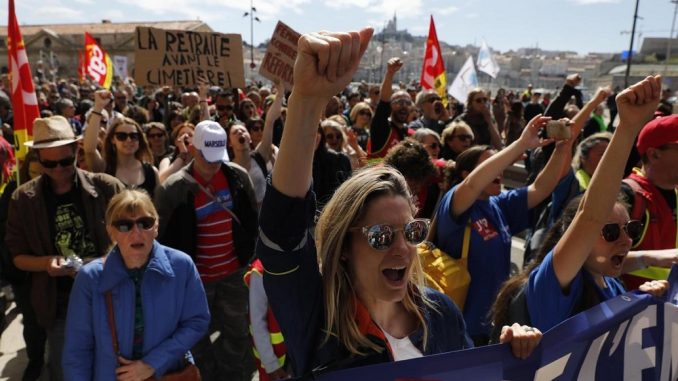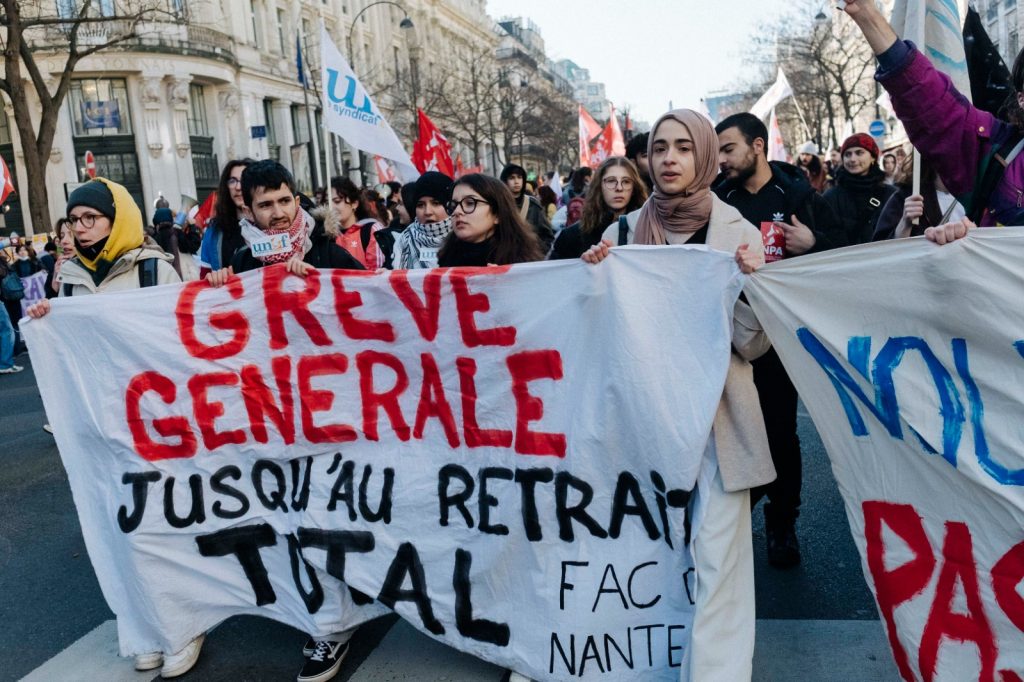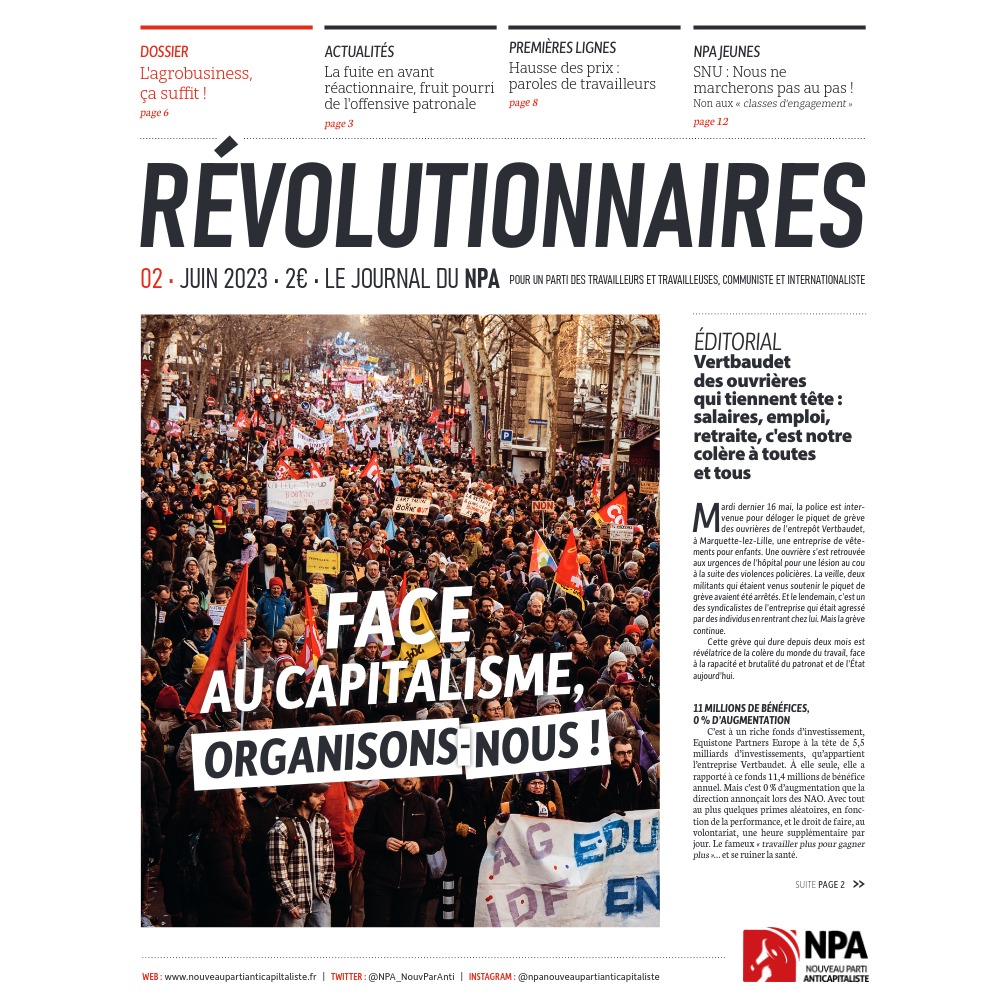
By Pablo Vasco
After four months of powerful struggle against Macron’s anti-pension reform, it is necessary to make an assessment of the movement, the role of its protagonists, the perspectives of the situation and the task of the revolutionary socialists.
1. A historic movement. Since January 19, France has experienced twelve national days of struggle, with strikes and massive demonstrations, against the reactionary reform of the Macron government and the capitalists that raised the retirement age from 62 to 64 and from 37.5 to 43 the years of contribution to collect the full benefit. The enormous social force deployed in this process confirms its historic character, comparable to other milestones such as the movements against the Juppé Plan (1995), the First Employment Contract law (2006) and the labor reform (2016), and superior to the struggle of the yellow vests (2018).
The strikes were in the majority among railway workers and other public transport workers, oil refiners, electricity and garbage collectors; strong strikes among teachers, chemists, health and other sectors, and partial strikes in other activities. The marches were of an unprecedented massiveness, even in small towns, with peaks of 3.5 million people in 400 districts all over France. Workers -many for the first time-, students, retirees and popular and middle sectors participated. During the conflict there were also stronger actions: pickets and strike funds, blockades of oil depots, ports and roads; occupations of the Paris Stock Exchange and other public offices; power cuts in stadiums, airports, municipalities and parliamentary meetings, and harsh confrontations between demonstrators and the police.
2. The continental and local framework. The French process against the pension reform was preceded by a powerful wave of workers’ strikes and mobilizations in Great Britain, in frank recovery after almost four decades since the defeat imposed by Thatcher in 1985. Apart from strikes and conflicts in Germany, Spain, Italy, Belgium, Portugal, Greece and other European countries, the British and French movements are the vanguard of the struggle in the Old Continent and express the entry on the scene of one of the main battalions of the global working class.
In France, since last October, there have been numerous strikes whose main demand was for wage increases: railroad workers, bus drivers, refinery workers, airport workers and several private companies. Low wages, poor working conditions and understaffing in public services, as well as annual inflation of 8%, which in foodstuffs reached 15%, are the main reasons for the strong social discontent that had been building up against the government and its austerity plan at the time of the launching of the reform project.
3. A weak but authoritarian government. Inaugurated in May 2022 after a run-off vote against the far-rightist Le Pen, Macron is a president considered “ill-elected” since he only obtained 38.5% of the national electoral roll and with a record abstention rate. His capitalist-imperialist government lacks its own parliamentary majority and depends on alliances with other blocs, which vary from case to case. Even so, with the support of the big bosses (Medef) it is determined to advance with its measures which are anti-worker (pension reform), anti-popular (cuts in social areas and unemployment benefits), anti-youth (regimentation via a “universal national service”) and anti-immigrant (greater requirements and immediate expulsions, laws currently under debate). The government of Macron and his Interior Minister Darmanin is increasingly authoritarian. If the French bourgeois-democratic regime is already very presidentialist, Macron accentuated its Bonapartist features.
He imposed his pension reform via anti-democratic decrees to limit the debate in the Senate (art. 47.1 and 44.3) and bypass the National Assembly (art. 49.3). The Constitutional Council validated it and twice rejected the option of a referendum, proposed by the institutional left (Mélenchon, LFI) and the far-right (Le Pen, RN).

Macron criminally intimidated sectors of strikers. He applied a harsh police repression, with dozens injured and hundreds arrested and prosecuted, including minors. The same in the face of the ecological struggle of Sainte-Soline, in the west of the country. It threatened human rights, environmental and anti-repression organizations. He restricted the right to demonstrate. He increased the military budget by 30%. Also he ordered a repressive operation on the island of Mayotte, a French colony in the Indian Ocean, against immigration from the sister Comoros Islands.
4. The Intersyndical and the new leadership. The pressure from the workers’ bases forced an unprecedented unity of the eight national centrals in the Intersyndical. Even without overflows, it had to call for twelve days of strike and mobilization, plus that of May 1st. But since its line was to put pressure on the government to decompress, it called in a piecemeal fashion without ever including the wage claim or reaching the strike for an indefinite period that would have made it possible to defeat the reform and the whole austerity plan of Macron and the bosses. The May Day march, which had not been unitary for 14 years, was massive. Now it is preparing to resume the “social dialogue” with the government, although it has called for a new national day of struggle for June 6, prior to the parliamentary debate of a bill to repeal the reform. Already in 2006, the mobilization forced the repeal of the precarious CPE law passed a few months earlier.
A weakness of the movement was the low level of self-organization of the vanguard and the strikers themselves. Overall, general assemblies were few and poorly attended. With unevenness, picket lines, action committees and interprofessional coordination bodies, such as the AG Interpro 92 (Hauts de Seine, western Parisian suburbs), emerged in various cities and trade union sectors. But they did not reach a sufficient development and extension to allow them to overwhelm the bureaucracy of the Intersyndical. Even so, the relative distrust of delegates and rank and file activists was expressed in the CGT, the most traditional and socially important central: in its tense congress last March, for the first time in its history, the official assessment was rejected by a slight majority and the secretary general was replaced by an unexpected candidate. The CFDT, the largest and most class-collaborationist central, also replaced its leader with a woman.
The student body increasingly joined the movement and, in addition to promoting its own actions, is the vanguard in the anti-repressive marches. At the university level, a National Student Coordination emerged, with delegates from 45 institutions and motions voted in assemblies. The traditional UNEF federation, led by the PS, broke up and a sector joined the student centers and groupings grouped in L’Alternative to create a new national federation with a militant tone: the Student Union. And the high school students resumed their usual method of blockades of their schools.

6. The politicization of the conflict. While sectoral struggles persist, especially over wages, the general process entered a phase of ebb. From an initial anti-reform character, the struggle became more and more politicized to jointly target Macron, his government and the whole capitalist plan of austerity. In the marches “Macron resign” or “Macron out” were chanted. Today the president and his ministers cannot attend a public event without suffering casseroles, protests or condemnations. The photo of the presidential procession in the middle of an empty Parisian avenue on May 8, anniversary of the end of World War II, illustrates well this isolation and political crisis.
This politicization implies that the working class has gained in consciousness and confidence in its own strength. For the first time in decades, unionization grew, with some 100,000 new members. At the same time, in the workers’ and students’ vanguard, above all in thousands and thousands of young activists who have become radicalized, and in grassroots sectors, there are changes in the head and the illegitimacy of the government, the political regime of the Fifth Republic and the capitalist system; the economic crisis, the crisis of this authoritarian democracy and what ways out there are; the role of the unions; environmental deterioration; the possibility or not of revolution and socialism, all very political issues are being debated.
In a framework of global polarization, it is possible that part of the discontent could be channeled by Le Pen, who has already promised that if she were the government, she would submit this “unjust and useless” reform to parliament or to a referendum. There were also some neo-fascist attacks on picket lines and union and leftist premises, and recently a march of 500 hooded demonstrators in Paris, risks not to be ignored. For its part, the institutional left alliance LFI supported the movement and recovered a little, but its axis is to make parliamentary opposition, it has internal leadership disputes and in the polls it is still behind Le Pen.
7. The debates in the revolutionary left. Overall, the entire far-left took part in the struggle, denounced the government, criticized the bureaucracy and proposed a general strike. However, several currents did so conditioned by its own political frames, which we believe are incorrect. Lutte Ouvrière, which has union insertion but shortly before the conflict insisted on the “setback” of the working class, acted in a defensive and propagandistic manner. It did not have either the dejected mandelist sector of Poutou and Besacenot, responsible for the deterioration of the NPA, which in last year-end congress divided the party to go after the LFI, and in accordance with this it proposes as a way out a Constituent Assembly.
Permanent Revolution deserves a separate paragraph. Two years ago it left the NPA on its own, instead of staying and working with the other internal revolutionary tendencies, which would have allowed them to win together the leadership of that party at the congress. During the conflict it set up its own “network for the general strike”, outside the genuine trade union coordinations. It tried the same at the student level. And although at one point it characterized “a latent pre-revolutionary situation”, which is a valid debate, it proposed a limited solution of the “radical democracy” type. The entire behavior of RP is sectarian, self-proclaimed and divisive, just like its international current and its mother party in Argentina, the PTS, inside the Left Front.
The revolutionary wing of the NPA, the party of which our comrades of the ISL France are militants, intervened in the movement, promoting the real instances of union and student coordination -with a leading role in the CNE-, and calling to defeat the reform, Macron and the whole capitalist plan. As a fundamental solution they propose a government of the workers and socialism on the basis of the organizations of self-determination of the class. In the process of struggle and the political crisis that continues they are winning new militants. It is one more step in the enormous political task that remains posed in France in the next period: to build a revolutionary socialist leadership, a party that regroups the revolutionaries and advances as an alternative of power in the face of future crises.








